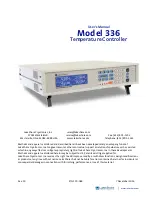
L-DALI User Manual
175
LOYTEC
Version 5.2
LOYTEC electronics GmbH
the default value. If no default value is defined, this property reads “N/A”. The default
is no default value.
Historic Filter
: This property allows defining historic filters for the scalar data point.
See Section 6.4.6.
Point Type
: This is the base data point type, e.g., “Analog Datapoint”.
Direction
: This is the data point direction. Use input, output or value as directions.
Unit
: For analog data points this property contains the definition of an engineering unit
of the scalar value, e.g., “kg”. A human-readable text for the engineering unit is
displayed and can be entered. If the unit is known by the Configurator as a convertible
unit, it is displayed with a green checkmark (see Section 6.1.13).
Unit for display
: If the data point has a convertible unit, an alternative unit for display
can be chosen. The data point value on the Web UI is converted to and displayed in the
display unit (e.g., °F instead of °C). For a non-convertible unit this option is not
available.
Analog Datapoint Max Value
: For analog data points this property contains the upper
limit of the supported value range. Note that this does not define an alarm limit.
Analog Datapoint Min Value
: For analog data points this property contains the lower
limit of the supported value range. Note that this does not define an alarm limit.
Analog Datapoint Precision
: For analog data points this property defines the number
of decimals. ‘0’ specifies an integer value. Display units may use this to format the
floating point value accordingly.
Analog Datapoint Resolution
: For analog data points this property defines the
smallest possible value increment.
Analog Point COV Increment
: This property is valid for analog input data points. It
specifies by which amount the value needs to change, before an update is generated. If
every write shall generate an update even when the value does not change, specify 0 as
the COV increment. If any value change shall generate an update, delete the value,
which results in
Any
.
Active Text
: For binary data points this property defines a human-readable text for the
active state (true).
Inactive Text
: For binary data points this property defines a human-readable text for
the inactive state (false).
Current State Map
: For multi-state data points this property defines the multi-state
map. It must be set to a valid multi-state map or it points to User/UndefinedStates.
Click on
to assign a state map.
State Count
: For multi-state data points this property defines the number of discrete
states.
State Text
: For multi-state data points this property defines a human-readable state
label for each state.
7.7.5 Tracking Data Point Usage
Data points can be used by other objects, such as connections, schedulers, math objects and
many more. To get an overview on data point usage, the data point list contains the column
Use. This column provides a usage counter of the individual data points. If usage is ‘0’ the
data point is not used by any other object.
If the usage count is larger than zero, choose the item
Show Usage …
from the data point
context menu. This opens up a report window showing the objects referring to the selected
data point. An example is shown in Figure 162.














































